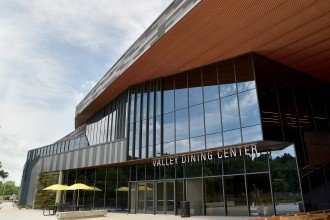
Valley Dining Center
KALAMAZOO, Mich.—Western Michigan University's Valley Dining Center was awarded a Gold certification in Leadership in Energy and Environmental Design, or LEED, demonstrating continued support for the strategic goal of sustainable stewardship. The second highest award of four levels of LEED certification, the achievement is evidence of WMU's commitment to excellence and sustainability in facility design and construction.
Achieving LEED Gold certification is a noteworthy achievement for a dining facility due to the complexity of its mechanical, electrical and plumbing systems, as well as the energy utilization and waste challenges that are inherent in a high-capacity food service facility.
"We are so proud to have been awarded LEED Gold certification," says Dr. Diane Anderson, vice president for student affairs. "This means we have succeeded in our commitment to advance environmental sustainability practices, while offering students an incredible space to gather and dine in the Valley Neighborhood."
SmithGroupJJR, a Detroit-based design, architecture and engineering firm, was integral in leading the project with a focus on excellence and sustainability.
Notable sustainability features in the Valley Dining Center include:
- An exterior living wall and green roof section.
- A sustainable rain garden that helps to keep 100 percent of stormwater on-site.
- Landscaping designed to be drought tolerant and require little to no irrigation.
- Energy efficient heating, ventilation, air conditioning, lighting and water systems.
- A Food Pulper and Water Extraction System that can reduce the typical food and scrap volume by 87 percent and save about 83 percent of the water.
- Harvesting, reclaiming or extracting as well as manufacturing 33 percent of building materials within 500 miles of the site.
- New dishwashers with energy-recovery units that use the steam generated during operation to pre-heat the water for further operations.
- Customizable made-to-order food options, right-sized portion and tray-less dining to help reduce food waste.
- Consolidation of dining facilities to enhance the collection of recyclable materials and post-consumer food waste.
The state-of-the-art dining center opened in fall 2016 to serve WMU students, faculty, staff and visitors in the Valley Residential Neighborhood. Thirty percent of the contractors who worked on the facility were from the Kalamazoo, Portage and Allegan areas. Designed to foster involvement, community and engagement, the two-story 61,152-square-foot facility overlooking Goldsworth Valley Pond has a seating capacity of just over 1,000. Its second floor features nine distinct food venues with fresh menu items prepared in front of customers in a restaurant-style dining environment. The ground floor includes Café 1903, a convenience store and café, with public gathering spaces and seating.
To commemorate the achievement, a plaque will be awarded to WMU Dining Services and displayed at the Valley Dining Center. An unveiling ceremony will be coordinated to honor the accomplishment in the fall.
Additional details about WMU's evolving neighborhood environments
For more WMU news, arts and events, visit WMU News online.
